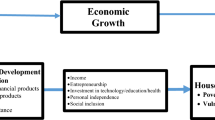Abstract
The HOGLEX demand system (Tran Van Hoa (1983, 1985)) is integrable and flexible in the sense that it is based on utility maximization and encompasses most other well-known demand systems (e.g., LINEX, AIDS) in the literature on consumer behaviour (Laitinen et al. (1983)). HOGLEX studies to date have been based on conventional OLS or MLE methods and panel aggregate income and price data, and restricted to investigating consumption patterns. The paper elaborates on three important subsets of the HOGLEX demand system and, using household expenditure unit records from two major ASEAN developing countries (i.e., Thailand and the Philippines), estimates by the Bayesian method these subsets for 20 socio-demographic cohorts, and discusses their substantial implications in social security and welfare policy analysis. We also estimate the models in the more practical case of measurement errors in total expenditure and compare the results with those without measurement errors.
Similar content being viewed by others
References
Chib S. and Greenberg E., (1995), “Understanding the Metropolis-Hastings Algorithm,” The American Statistician 49: pp. 327–335.
Deaton A. and Muellbauer J. (1980), Economics and Consumer Behavior, Cambridge University Press, Cambridge.
Doornik J. A. (2001), Ox 3.0: An Object-Oriented Matrix Programming Language, London: Timberlake Consultants Ltd.
Gelfand A. E. (1996), “Model Determination using Sampling-based Methods,” Markovchain Monte Carlo in practice (Gilks W. R., Richardson S. and Spiegelhalter D. J. eds.), Chapman & Hall, London.
Hasegawa H. and Kozumi H. (2001), “Bayesian Analysis on Engel Curves Estimation with Measurement Errors and an Instrumental Variable,” Journal of Business and Economic Statistics 19: pp. 292–298.
Hausman J. A., Newey W. K. and Powell J. L. (1995), “Non-linear Errors in Variables: Estimation of Some Engel Curves,” Journal of Econometric 65: pp. 205–233.
Jerison D. and Jerison M. (1984), “Demand Aggregation and Integrability of the HOGLEX Demand Function,” Economics Letters 15: pp. 357–362.
Laitinen K., Theil H. and Raparla T. (1983), “A Generalization of Working’s Model,” Economics Letters 13: pp. 97–100.
Lewbel A. (1996), “Demand Estimation with Expenditure Measurement Errors on the left and right hand side,” The Review of Economics and Statistics 78: pp. 718–725.
Mallick B. K. and Gelfand A. E. (1996), “Semi-parametric Errors-in-variables Models: A Bayesian Approach,” Journal of Statistical Planning and Inference 52: pp. 307–321.
Muellbauer J. (1995), “Aggregation, Income Distribution and Consumer Demand,” Review of Economic Studies 42: pp. 525–543.
Raftery A. E. (1996), “Hypothesis Testing and Model Selection,” Markov chain Monte Carlo in practice (Gilks W. R., Richardson S. and Spiegelhalter D. J. eds.), Chapman & Hall, London.
Tran Van Hoa (1983), “The Integrability of Generalized Working Models,” Economics Letters 13: pp. 101–104.
Tran Van Hoa (1985), “Effects of Income Distribution on Household Income,” Economics Letters 18: pp. 397–399.
Author information
Authors and Affiliations
Corresponding author
Rights and permissions
About this article
Cite this article
Hasegawa, H., Van Hoa, T. & Ma. Valenzuela, R. Hoglex Demand Systems and Welfare Policy in Major Asean Developing Countries: A Bayesian Analysis Using Expenditure Unit Records. J. Quant. Econ. 1, 52–65 (2003). https://doi.org/10.1007/BF03404648
Published:
Issue Date:
DOI: https://doi.org/10.1007/BF03404648



